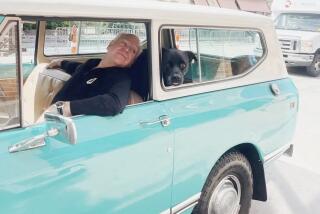Fire Damages Suspected Libya Poison Gas Plant
- Share via
WASHINGTON — Libya’s official news agency said Wednesday that a fire has damaged a factory that U.S. officials have charged makes poison gas, and the agency said Libyan officials would not “rule out Israeli or American sabotage.”
President Bush, however, denied any U.S. involvement in the fire, which may have severely damaged the facility. A spokesman for the Israeli Foreign Ministry said that his government has no information about the incident, and an Israeli army spokesman said in Jerusalem, “It has nothing to do with Israel.”
ABC News quoted unidentified Libyan sources who said that the plant, near the town of Rabta, about 60 miles southwest of the Libyan capital of Tripoli, had burned to the ground.
White House Press Secretary Marlin Fitzwater said the United States has been told that Libya had closed its borders, but Administration officials were unable to confirm the report. There were conflicting reports from other sources.
U.S. officials cited diplomatic sources for their initial information about the fire and said the first reports had come from Italy. Tunisia, one of Libya’s neighbors, also passed along information about the fire.
U.S. officials said the government planned to “do some satellite checking” to monitor the situation, but they noted that satellite images of the plant would probably not be available until early this morning.
Last week, Fitzwater said the United States had solid information that the plant was manufacturing poison gas. U.S. officials said the plant was making substantial amounts of mustard gas and, perhaps, more sophisticated nerve gases.
The plant “is dangerous and becoming more so,” Fitzwater said at the time, calling for “vigorous efforts to stop the operation.” He also pointedly refused to rule out a military operation against the plant, saying only that “we don’t rule anything out.”
On Wednesday, when asked by reporters who encountered him at the White House if he could rule out American involvement in the fire, President Bush responded: “Absolutely.”
Fitzwater echoed Bush’s statement, saying, “We deny we had any involvement.”
A spokesman for the official Libyan news agency Jana, reached by Reuters news agency on Wednesday night, confirmed reports that a fire had started Wednesday morning at the factory.
Asked how the fire began, the spokesman said that Libya “does not rule out Israeli or American sabotage.” He gave no details of damage to the plant other than to say “the fire is basic.”
Mahmoud Azzabi, press secretary at Libya’s U.N. Mission in New York, also confirmed the fire. “There is speculation that it was possibly sabotage, somebody coming in from Tunisia,” he said.
Despite repeated reports of poison gas production at the Rabta plant, Libya consistently has insisted that the plant is making only pharmaceuticals. Libyan officials, however, have refused to allow Western journalists to see the factory.
The one abortive attempt Libya made last year to convince outsiders that the plant was harmless only reinforced suspicions that the Libyans had something to hide.
In January, 1989, the United States dispatched a carrier task force from the 6th Fleet to coastal waters off Libya in what was seen as an effort to intimidate Libyan leader Moammar Kadafi into shutting down the newly built plant.
With memories of the 1986 U.S. air strikes against Tripoli and Benghazi still fresh in their minds, the Libyans took the U.S. warnings about the Rabta plant seriously and invited foreign journalists to visit the facility.
What little the journalists were allowed to see, however, did not seem to be consistent with Libya’s contention that the plant was built to make pharmaceuticals.
The plant, a series of low, windowless buildings flanked by clusters of large concrete storage tanks, was surrounded by batteries of French-made Crotale anti-aircraft missiles. Radar sites dotted the hills overlooking the plant.
The journalists were taken to a cafeteria for foreign construction workers about a mile from the plant. They were kept under tight surveillance and not allowed to speak to any of the workers. They were then addressed by a Libyan official, who repeated the assertion that the plant had been built to make pharmaceuticals.
Held in the cafeteria until well after nightfall, the journalists finally were herded onto buses and driven past the outskirts of the unlit plant without stopping. Back in Tripoli, they were informed that they all were being expelled from the country.
No explanation was given, but the Libyans were apparently upset by reports quoting diplomats in Tripoli as saying they were convinced that the plant was meant to produce chemical weapons.
Diplomatic and intelligence sources who specialize in Libya believe that the Rabta plant went into limited operation in mid-1989, producing mustard gas. It probably would have begun production sooner, the sources said, had it not been for U.S. warnings.
Times staff writer Nick B. Williams Jr. in Jerusalem contributed to this report.
BACKGROUND
The United States first charged in late 1988 that Libya was making chemical weapons, apparently mustard gas and nerve agents, at a plant at Rabta, about 60 miles southwest of Tripoli. The government of Libyan strongman Moammar Kadafi denied the charge and said that plant was only making pharmaceuticals. Washington applied pressure to foreign firms (primarily West German) that supplied technology for the plant, calling on them to stop helping the Kadafi regime. The furor over the plant calmed down until February of this year, when West German sources reported that Libya had produced enough poison gas for 1,000 artillery shells. Last week, the White House charged that Libya had renewed production of “chemical weapons,” posing “a major threat” that required “vigorous efforts” to shut down the plant.
More to Read
Get the L.A. Times Politics newsletter
Deeply reported insights into legislation, politics and policy from Sacramento, Washington and beyond. In your inbox twice per week.
You may occasionally receive promotional content from the Los Angeles Times.










